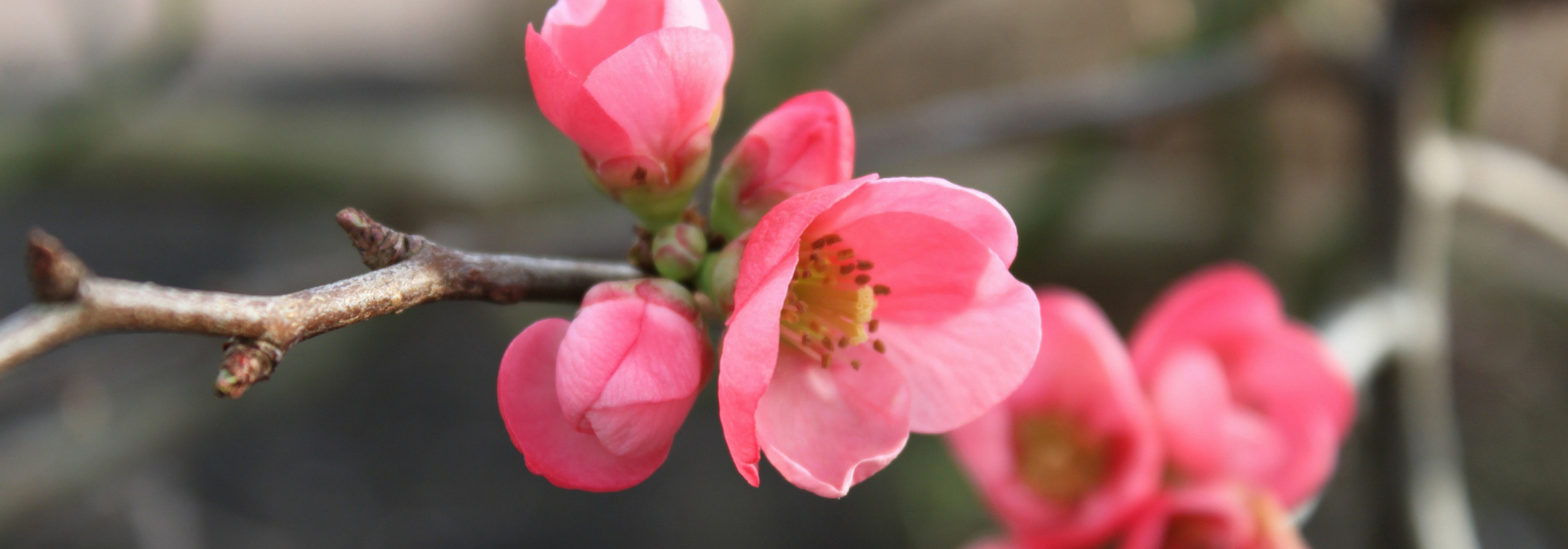
Japanese quince: planting, pruning and maintaining
Contents
Japanese Quince in a nutshell
- They are highly valued for their early flowering at the end of winter and their decorative fruits in autumn
- Their pink, red, or white flowers appear on the naked branches, before the foliage
- They are vigorous deciduous bushes that are perfectly hardy (-20°C)
- Easy to grow, they thrive in all soils and are drought-resistant once established
- Their stocky silhouette fits well in borders, as a defensive hedge, and even in containers
A word from our expert
Often confused with Japanese apple trees, the Japanese quinces or Chaenomeles are very beautiful shrubs remarkable for their early flowering, at the very end of winter on the still naked branches. Their delicate and vibrant flowers, pink, coral, scarlet red, orange, and there are also pure white Japanese quinces, sometimes even tinged with green, enliven the garden still asleep from the cold and create extraordinary displays.
This profusion of flowers gives way in autumn to small fruits resembling apples or miniature quinces, which are very fragrant when ripe and delicious in jams.
These hardy, spiny shrubs are easy to grow in full sun or partial shade, in ordinary soil that is rather cool but well-drained and protected from stagnant moisture.
Versatile, they can be used in borders as well as in isolation or in a defensive hedge where their spiny branches prove formidable, in orchards, trained against a wall or in pots shaped as bonsai for a Japanese touch.
Compact and resistant to pollution, they are excellent shrubs for city gardens where they will bring a touch of cheerfulness and graphic appeal.
These early flowering spring shrubs are highly valued for their floribundity and unusual silhouette, thriving in all natural gardens, in romantic English gardens or more contemporary styles. With their graphic, twisted branches, they are very decorative in minimalist Ikebana-style arrangements.
From Chaenomeles japonica to Chaenomeles speciosa and Chaenomeles x superba, discover all our tips for growing, caring for, and maintaining the Japanese quince.
Botany
“`html
Botanical data
- Latin name Chaenomeles
- Family Rosaceae
- Common name Japanese Quince, Flowering Quince
- Flowering From February to June
- Height 1 to 5 m
- Sun exposure Sun, partial shade
- Soil type All, well-drained
- Hardiness -20°-25°
Japanese Quinces or Chaenomeles, are deciduous shrubs, most often thorny. Perfectly hardy, they acclimatise almost everywhere.
The genus C. japonica which is the type species native to Japan and three Chinese species, C. cathayensis, C. speciosa and C. thibetica. There are few species, but many cultivars have been developed. Chaenomeles x superba is an excellent hybrid of Chaenomeles japonica and Chaenomeles speciosa of which there are many varieties.
There are two categories of Chaenomeles: C. superba which produce smaller but more numerous flowers, and have a more compact habit and a slightly more twisted branching than C. speciosa. The latter are recognised by their large flowers. They are slightly later than C. superba and also a bit taller.
All these species and their various hybrids are commonly known as ‘Japanese Quince’ despite their different origins. They are also called ‘Flowering Quinces’ as opposed to the fruiting quince (Cydonia oblonga) and they are sometimes confused with ‘Japanese Apples’ which belong to the genus Malus.
Their more or less spreading silhouette varies depending on the species and offers a great heterogeneity of size, ranging from small bushes of 1 m, valuable as ground cover to shrubs like C. cathayensis which can reach 3 m high and almost as wide. While most form a dense, compact bush, rounded and upright, Chaenomeles japonica is distinguished by its more prostrate growth.
Growing quite rapidly, these shrubs reach two-thirds of their adult height in five years and become denser over the years.
The Chaenomeles form shrubs with a rather chaotic bushy habit with branches covered in fine intertwined thorns mixed with more rigid vigorous shoots. Some cultivars like Chaenomeles speciosa ‘Mango Storm’ or Chaenomeles speciosa ‘Scarlet Storm’ are thornless.
Japanese Quinces flower as early as February in some regions. They are covered with a multitude of cup-shaped flower clusters, remarkable because they appear before the leaves, on the still bare branches when the garden is still at rest and often bare.
From the end of winter until June, they dot the bare wood with their small bright corollas until the appearance of the young foliage, opening in dozens, grouped in 2 or 5 on the spiny branches of the previous year.
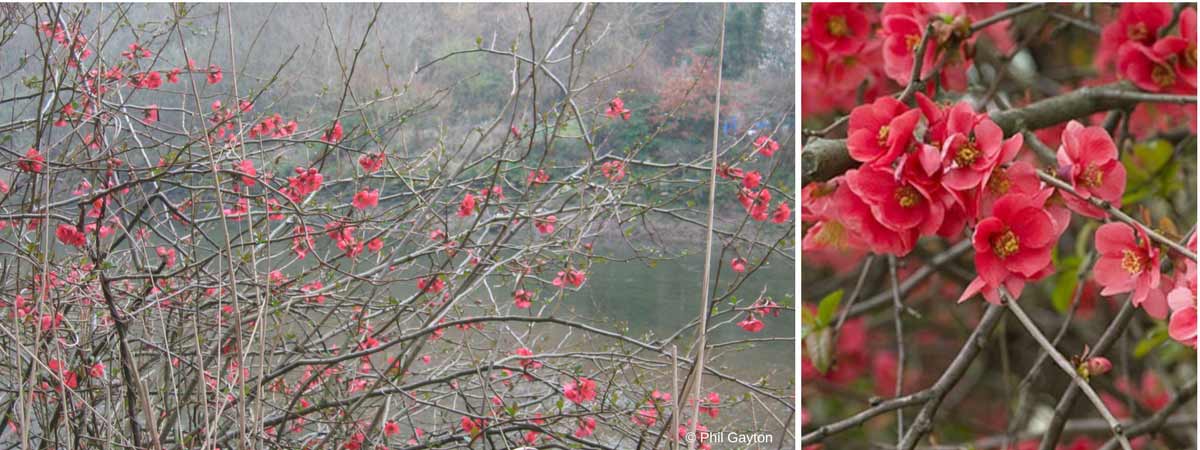
They literally transform these shrubs with a slightly stiff habit, giving them a spectacular dimension. The flower buds resembling small sugar candies will be magnificent under late frost.
This flowering lasts about 3 to 4 weeks.
All delicate, these slightly waxy corollas come in an infinite variety of colours ranging from the brightest red to pure white, including all shades of pink and salmon, from pale pink to purplish pink with a darker reverse. Some are slightly fragrant.
The Chaenomeles speciosa Eximia is covered with a multitude of carmine pink flowers, ‘Hot Fire’ stands out from other quinces with its fire red flowering and ‘Kinshiden’ bears green flowers tinged with cream white of rare elegance.
Coral orange, soft salmon pink, bright pink or white depending on the species, the flowers have a single, semi-double or double corolla, 3 to 6 cm in diameter for the largest (Chaenomeles speciosa ‘Mango Storm’), sometimes composed of many petals, sometimes delicately crumpled, overlapping in some varieties, resembling more those of certain roses or camellias than those of quinces. Often barely opened, they reveal a heart of yellow stamens.
These bare thorny branches but dotted with flowers are very graphic in a bouquet and precious in Japanese Ikebana compositions. They make excellent bonsais highly prized by the Japanese due to their airy and abundant flowering.
In autumn, this flowering gives way to small decorative and highly fragrant fruits, provided that several plants are planted, similar to small apples or small quinces, yellow, sometimes green washed with purple that persist long on the shrub after the leaves fall. Some sterile hybrids do not produce fruit.
Sour in taste, they are however edible once cooked into jelly, in jams, they are also used in the making of liqueurs. However, they are less tasty than the classic quinces from fruiting quinces (Cydonia oblonga). They are mainly of olfactory interest. Their scent is so close to ylang-ylang that a perfume was once made from it; ‘Cananga essence’.
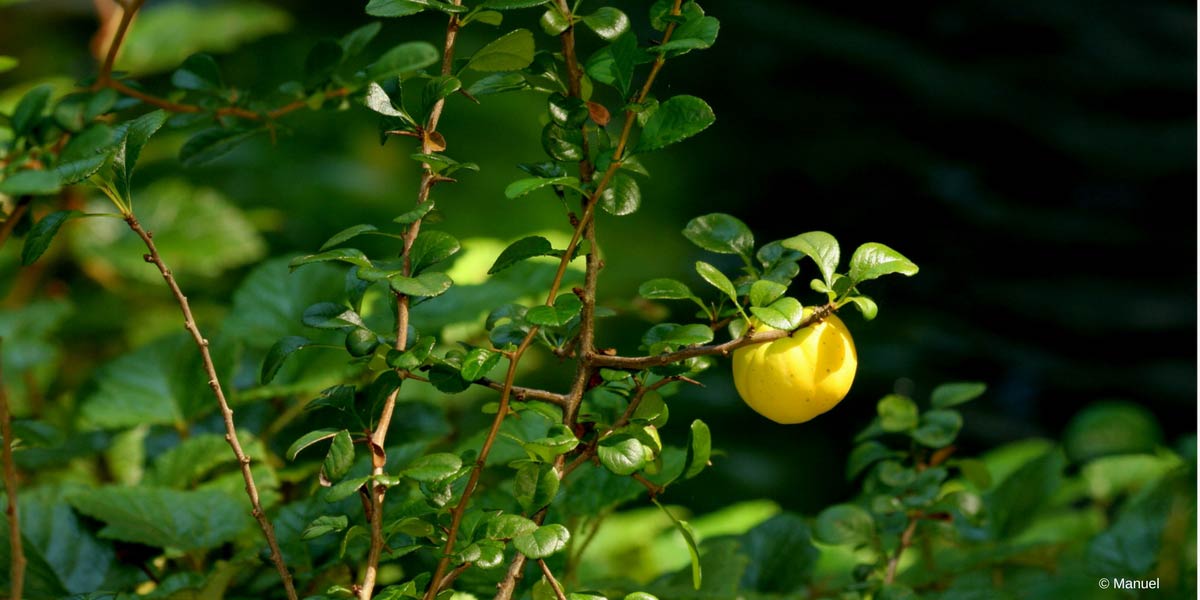 In autumn, the foliage is another asset of the Japanese Quinces. It emerges on the bare brown branches at the same time or shortly after flowering. Medium green to glossy dark green in spring, the narrow lanceolate leaves, veined, 2 to 12 cm long, adorn themselves in autumn with golden yellow hues sometimes washed with crimson before falling at the first frosts.
In autumn, the foliage is another asset of the Japanese Quinces. It emerges on the bare brown branches at the same time or shortly after flowering. Medium green to glossy dark green in spring, the narrow lanceolate leaves, veined, 2 to 12 cm long, adorn themselves in autumn with golden yellow hues sometimes washed with crimson before falling at the first frosts.
Japanese Quinces are perfectly hardy shrubs, they withstand temperatures down to -25 °C and adapt to all regions as they fear neither heat nor cold.
To flower well, they require a non-burning sunny exposure, although they also adapt to partial shade. They are planted in any ordinary soil that is not too calcareous, well-drained, remaining cool. Once established, after three years of cultivation, they withstand everything, drought as well as air pollution, making them well suited to the urban atmosphere of city gardens.
The compact yet elegant silhouette makes Japanese Quinces more versatile shrubs than they appear. They find their place in all natural gardens even in small spaces, forming lovely focal points.
They always bring to the garden a very graphic contemporary note, which lends itself to the Japanese-inspired compositions highly appreciated by bonsai enthusiasts. They can be grown in groups associated with other shrubs on a bank or in a bocage hedge, in a living hedge or even in a defensive hedge with their sharp thorns. They also do wonderfully in pots or trained along a wall. The smaller ones will form a large ground cover on a bank, alongside creeping ceanothus for example.
They are associated with the early flowering of Lilacs or Forsythias, with a profusion of spring bulbs like tulips or daffodils or with more creeping plants like hardy geraniums or euphorbias that will cover their base.
Their twisted and thorny branches dotted with small candid vermilion or soft pink flowers are very often depicted in the landscapes of Japanese prints.
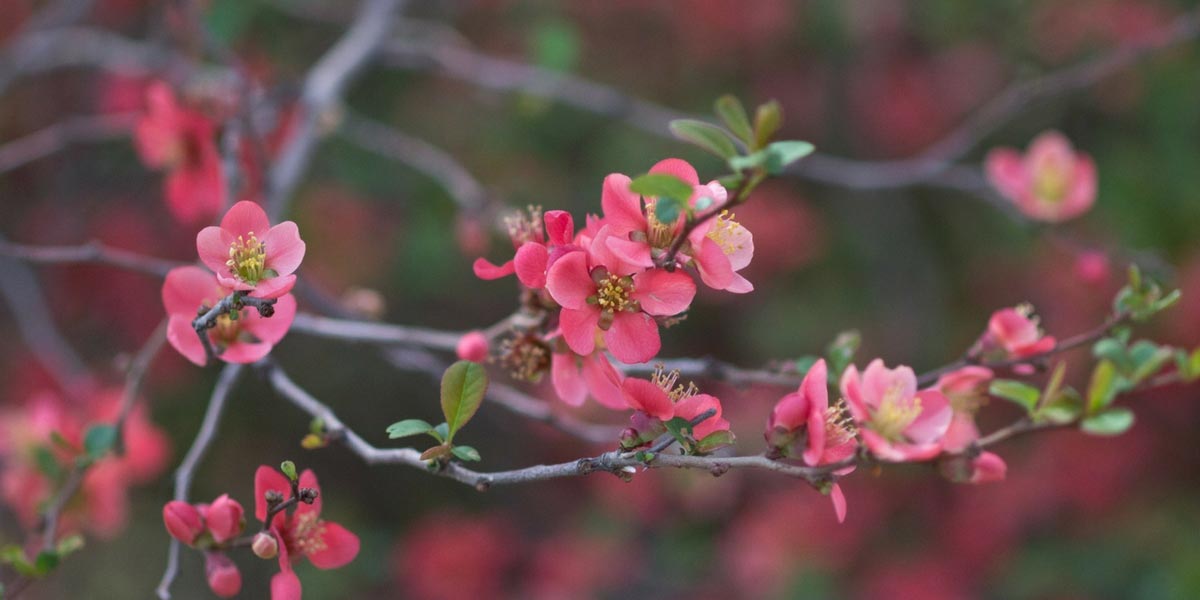
“`
Read also
How to propagate Japanese quince?Species and varieties
Three species of Japanese quinces are known, but there are hundreds of hybrids and cultivars. The authentic Japanese quince is Chaenomeles japonica, which is spiny and bears red or orange flowers. Together with the type species C. speciosa, it has given rise to numerous hybrids known as Chaenomeles x superba. They have a more globose habit and intermediate sizes of 1 to 1.5 m. The third species is C. cathayensis, which is taller (5 m) and also bears the largest fruits.
Their size ranges from dwarf bush to large bush, and the flower colours vary from bright red to pure white, including the most delicate pinks or salmon, as well as the presence or absence of thorns.
For bonsai cultivation, prefer the almost creeping and well-twisted cultivars, not too large, thus easy to control, such as ‘Falconet Charlet’ with its lovely double pink flowers; they develop beautiful ramified branches with little effort. Discover our collection of Japanese quinces, including some exclusively!
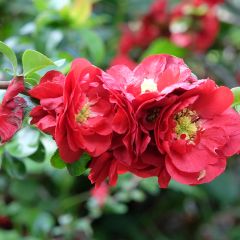
Chaenomeles speciosa Scarlet Storm - Flowering Quince
- Flowering time April, May
- Height at maturity 1 m
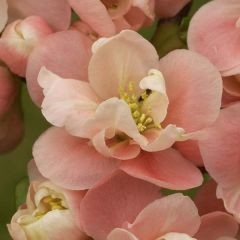
Chaenomeles speciosa Falconnet Charlet - Flowering Quince
- Flowering time April, May
- Height at maturity 2 m
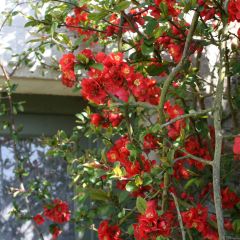
Chaenomeles speciosa Fire dance - Flowering Quince
- Flowering time April, May
- Height at maturity 2 m
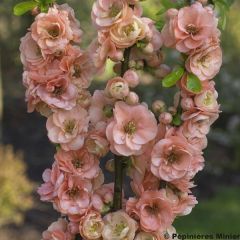
Chaenomeles superba Cameo - Flowering Quince
- Flowering time April, May
- Height at maturity 1,50 m
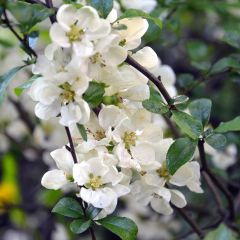
Chaenomeles speciosa Nivalis - Flowering Quince
- Flowering time April, May
- Height at maturity 2,50 m
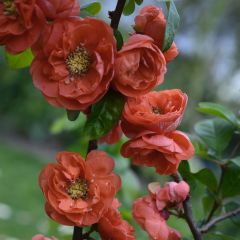
Chaenomeles speciosa Mango Storm - Flowering Quince
- Flowering time April, May
- Height at maturity 1 m
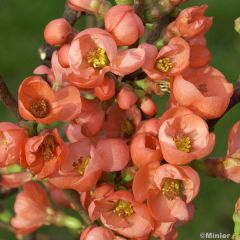
Chaenomeles speciosa Friesdorfer - Flowering Quince
- Flowering time April, May
- Height at maturity 2,50 m
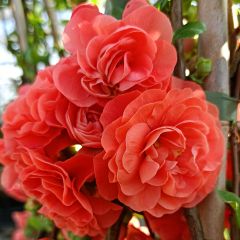
Chaenomeles speciosa Orange Storm - Flowering Quince
- Flowering time April, May
- Height at maturity 1,20 m
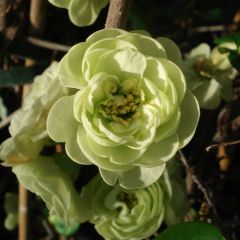
Chaenomeles speciosa Kinshiden - Flowering Quince
- Flowering time April, May
- Height at maturity 2 m
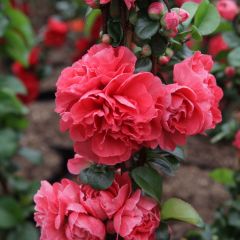
Chaenomeles speciosa Pink Storm - Flowering Quince
- Flowering time April, May
- Height at maturity 1 m
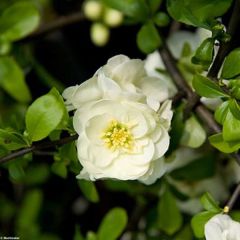
Chaenomeles speciosa Yukigoten - Flowering Quince
- Flowering time April, May
- Height at maturity 1 m
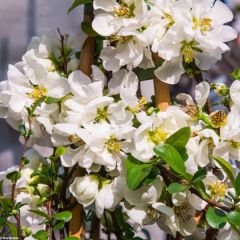
Chaenomeles superba Jet Trail - Flowering Quince
- Flowering time April, May
- Height at maturity 1,50 m
Discover other Chaenomeles - Quince tree
View all →Available in 1 sizes
Available in 1 sizes
Available in 1 sizes
Available in 1 sizes
Available in 2 sizes
Available in 1 sizes
Available in 1 sizes
Available in 2 sizes
Available in 2 sizes
Available in 1 sizes
Planting the Japanese quince
Where to Plant
With excellent hardiness, Japanese quinces can withstand very low temperatures of -20°C, ensuring perfect resilience in all regions.
Not demanding, they grow in any soil, even poor, acidic or calcareous, as long as it is fresh and well-drained, in sunny situations without scorching sun or in partial shade. They only fear very heavy and waterlogged soils.
Once well established, they can tolerate everything: sun as well as drought. They are not afraid of heat, cold, or even air pollution, making them good candidates for gardens or urban balconies.
These thorny plants can be cultivated in the centre or at the back of a border or in groups alongside other bushes, such as in a bocage hedge or a living hedge. They also form deterrent hedges up to 3 m high. They will also fit perfectly in an orchard, as their small fruits are edible once cooked.
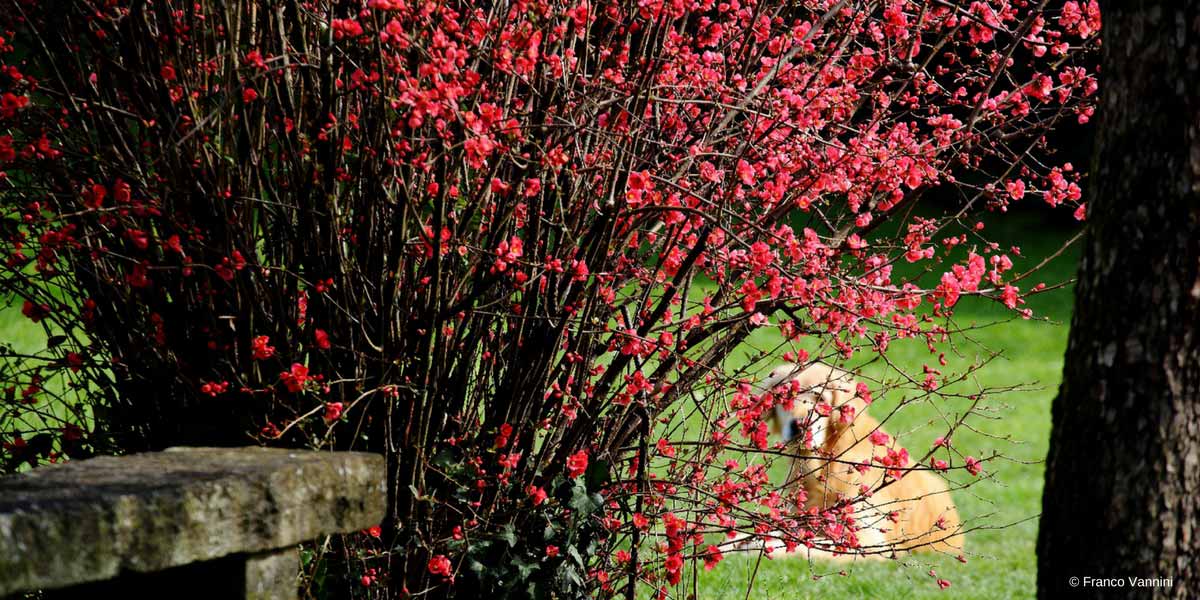
They can be trained against a wall, near the house to tame their natural tendency to become tangled. However, avoid planting them in low hedges or in pathways; their thorns penetrate deeply into the skin.
Some, like the Japanese quince ‘Sargentii’, also form large ground covers on a slope or spectacular bonsais that retain the normal size of their flowers on miniaturised bushes.
The low varieties (‘Fire dance’) can be planted in pots and even trained as bonsais.
This way, you can enjoy their vibrant flowering in spring and their fragrant small fruits on the terrace or near entrances in autumn.
When to Plant
Plants purchased in pots can be planted from October to March, avoiding periods of frost or extreme heat. However, planting in autumn, from September to November, will promote good rooting of the bush before winter.
How to Plant
In hedges, space Japanese quinces 80 cm to 1 m apart depending on the varieties, reducing this planting distance to 50 to 80 cm in borders. They can also be planted in groups of 3 or 5, in clumps, and will offer an enchanting display as winter ends.
In Open Ground
- Dig a hole that is 2 times larger than the container.
- Add a good amount of pumice to ensure perfect drainage
- At the bottom of the hole, spread a layer of well-decomposed compost
- Plant the bush at the collar level in the centre of the hole
- Bring the soil back to encase the roots and fill the hole with the extracted soil mixed with potting soil in equal parts
- Firm down with your foot and water generously at planting and regularly during the first summer
Planting in a Hedge
Dig a trench 30 to 50 cm deep and 20 to 30 cm wide. Space the bushes about 1 m apart. Staking is not necessary.
Trained Against a Wall
The branches of Japanese quinces can climb to 3 m and are easily trained.
- Attach the shoots as they grow
- Encourage lateral branches by removing the others
In Pots
- Choose low-growing varieties like Chaenomeles ‘Nicoline’ or ‘Hot Fire’
- Choose a container that is large enough (30 to 50 cm in diameter) and tall (at least 60 cm) for the bush to develop well
- At the bottom of the planting hole, ensure perfect drainage with clay balls or pumice
- Place the bush in a mix of garden soil and good potting soil
- Choose a sunny or partially shaded location in southern regions
- Water regularly, twice a week in summer
- Repot every two years into a larger container
Read also How to Grow a Japanese Quince in a Pot?
Maintenance, pruning and care
Rustic, drought-resistant as well as resistant to air pollution, Japanese Quince are vigorous bushes requiring no specific maintenance. Once well-rooted after 2-3 years of cultivation, they need little watering.
Provide the base of the bush with well-matured compost each year in spring and autumn.
Pruning the Japanese Quince
While they do not require special pruning, it is advisable to occasionally shorten the entangled branches that disrupt the habit of the bush or those that are too long and may become less floriferous. Over time, these bushes tend to form a somewhat chaotic tangle of branches. In June, after flowering, every 2-3 years, carry out a rejuvenating prune:
- Shorten the branches by a third, just above the lower branching or an eye
- Remove excess branches, dead or broken wood
- Well thin the centre of the branching by eliminating crossing branches to allow air and light to circulate
On trained bushes, cut back in May, every year, the previous year’s shoots to 2-3 eyes from the main branch.
Pruning as Bonsai
Naturally small, some Chaenomeles are interesting to work as bonsai: the leaves can be miniaturised but the flowers retain their size! For this, formation pruning is necessary in the early years. They suffer little from even severe pruning.
Remove all suckers as soon as they appear and carry out short prunes after flowering. This will lead to the formation of a nodose trunk, but be patient, it will take at least 5 years to achieve a trunk width of 2 cm.
Diseases and potential pests
Japanese quinces are vigorous flowering bushes that exhibit fairly good resistance to diseases.
Canker, aphids, and mealybugs, identifiable by the presence of farinose clusters, can, however, weaken them. Against the latter, in spring, treat the stems with sprays of a mixture of vegetable oil (rapeseed or olive oil), 90° alcohol, and black soap, which help to suffocate them; repeat if necessary every 2-3 weeks. In case of a severe infestation, cut and burn the infested parts.
If the weather is mild and humid in spring, the Japanese quince may be sensitive to scab, a fungus that blackens the foliage and deforms the fruits; treat preventively in spring and autumn with Bordeaux mixture. If powdery mildew threatens with its white fluff: spray with nettle manure or a horsetail decoction.
Despite their robust character, Japanese quinces can fall victim to bacterial fire, a formidable disease that particularly affects the Rosaceae family and can kill the bush within weeks. The leaves show rust spots, and the flower buds and leaves dry out and blacken as if the bush had been burned by fire. The only solution is to prevent attacks in March-April by spraying Bordeaux mixture or a horsetail decoction and to prevent contamination that can spread to neighbouring bushes by cutting 20 to 30 cm below the affected parts and then burning them.
The bush can also be affected by quince moniliosis in humid weather. The flowers dry out and fall, branches do too, and the fruits rot on the tree: treat with Bordeaux mixture in autumn after the leaves have fallen.
→ Also read our advice sheet Diseases and pests of the Japanese quince.
Multiplication
The propagation of the Japanese Quince can be done by sowing after stratifying the seeds in the typical species or by semi-woody cuttings or layering in hybrids. We recommend these last two methods as they are quicker and simpler; the young plants thus propagated will flower in the first year, unlike Quinces from sowing which will only produce flowers five years later.
Propagating by Cuttings
- From August to September, take 25 cm cuttings from lateral shoots on semi-ripe wood
- Remove the lower leaves, leaving only 2-3 leaves
- Plant them in a light mixture of river sand and turf
- Cover with plastic film and keep at 16-20°C.
- Keep the substrate moist until rooting, which takes 1 to 3 months
- Pot the cuttings individually in October-November in a light potting mix. Place under a frame or bell to protect from frost in winter
- Plant your cuttings in the ground the following spring; flowering will occur in the first year
→ Read also: How to propagate the Japanese Quince by cuttings?
Layering
- In autumn, lay a low, flexible branch of the bush down, angling it towards the ground for about 20 cm
- Clear the leaves from this point
- Dig a hole 7 to 10 cm deep to form a small trench
- Incise the branch and bury it, filling with compost (hold it in place if necessary with stakes or pegs)
- Water this layer generously
- The following spring, you can separate the layer from the parent plant if it has enough roots; otherwise, wait until autumn
- Cut the stem at the point where it enters the soil
- Plant directly
Associate
As soon as winter ends, their bare branches adorned with small, vibrant flowers in pink, red, or white will provide a beautiful backdrop for a lovely diversity of plants. Japanese Quince thrive almost anywhere in the garden, whether at the back of a flowerbed or grouped in free-standing or defensive hedges, in spring pots on the terrace or balcony, or even trained against a wall.
Essential in spring scenes, Japanese Quinces find their place in natural gardens, in bright undergrowth, surrounded by spring bulbs whose flowering coincides with their blooms; daffodils, squills, hyacinths, botanical tulips, and crown imperials.
In a country hedge, they can be combined with other spring-flowering bushes, such as yellow or white Forsythias (abeliophyllum distichum), Lilacs, Japanese cornels, flowering cherries, ornamental apples, Ribes x gordonianum or Gordon’s currant.
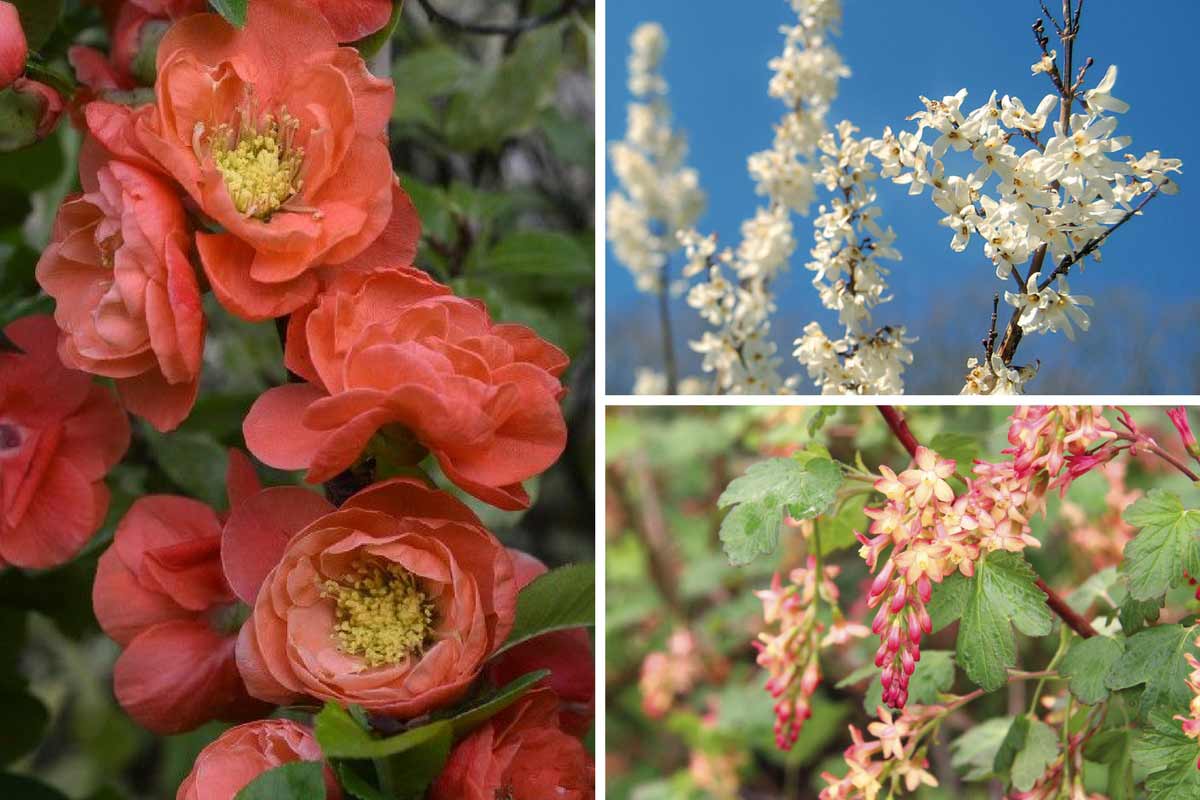
Chaenomeles speciosa Mango Storm – Abeliophyllum distichum – Ribes gordonianum
They are perfect for defensive hedges alongside hawthorns, berberis, blackthorn, or other decorative fruiting shrubs like sea buckthorns, or even edible ones such as strawberry trees.
In a flowerbed, pair them with corylopsis or false hazels, camellias, and low perennials such as heucheras, euphorbias, or hardy geraniums to cover the base of the quinces. Buddleias will take over the flowering.
On a slope, they blend well with a bush rose, rosemary, or creeping junipers or ceanothus. Trained against a wall, near the house alongside fragrant shrubs like honeysuckle or winter jasmine, they will create enchantment with every passing.
→ Discover more beautiful association ideas with Japanese Quince in our advice sheet!
Useful resources
- They are among the earliest flowering bushes, the Japanese quinces herald the start of spring!
- White quinces, with double flowers or thornless, we have them all!
- Discover 7 early flowering Japanese quinces
- Check out our tutorial: How to prune and train a Japanese quince?
- To properly choose a Japanese quince, visit our advice page!
- Our tips in The 9 best varieties of Japanese quinces to grow in pots
- Our advice on how to revitalise an old Japanese quince.
- The quinces by flower colour: Japanese quinces with pink flowers: the spring awakening of the garden; Japanese quinces with orange flowers: for a vibrant garden at the end of winter; Japanese quinces with red flowers: a splash of colour in the heart of winter.
- Subscribe!
- Contents


































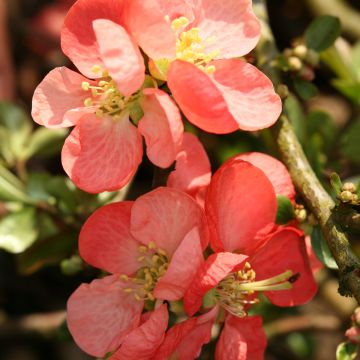

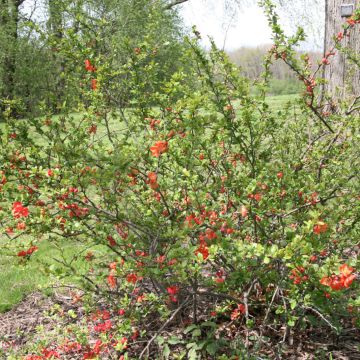
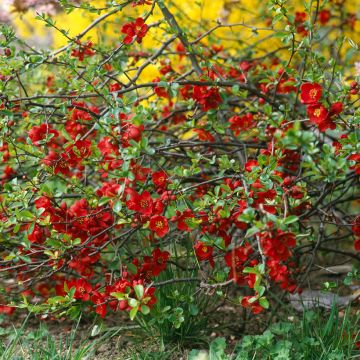
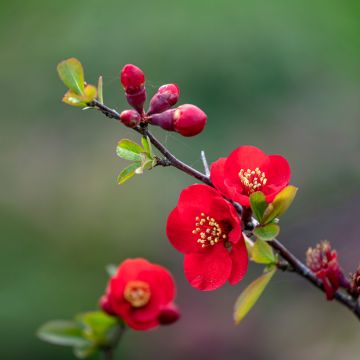

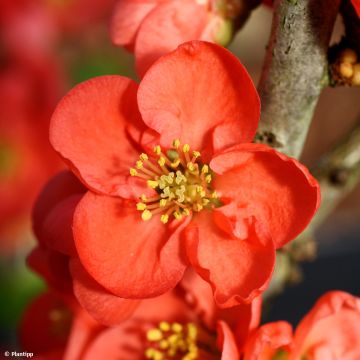
Comments